7 easy, effective water saving garden tips
Why do you need water saving garden tips? You probably have rain drumming down on your roof at this very moment.
However, we use 30-60% of our household water in the garden during the summer. And even in ‘rainy England’, we experience droughts and hose pipe bans every few years.
And if your water is metered, then water saving garden tips will help you save money.
The charity Hubbub is running a #tapchat campaign to conserve water. They say that the South East of England, where we live, gets much the same rainfall as Melbourne, Australia.
Oddly enough, I spend about several weeks a year in Melbourne where I’ve met some wonderful garden owners. Everyone’s attitude towards water is quite different from here. They are much more aware of the need to save water than we are.
Links to Amazon are affiliate, see disclosure.
If you prefer a video
You can see this post in this video:
Water saving garden butts?
Let’s start with water butts. Yes, they save water. And saving water saves money if you’re metered (see more below!).
But, in the South East of England, Melbourne and any other ‘water-stressed’ part of the world, you need large water butts. I’d suggest starting at 210 litres, and if you can fit a bigger one in, go for it.
I have a 90 litre water butt attached to a small garden shed. It waters my garden for 3-4 days. Last summer, we had a nine week drought. So it stood empty for most of the summer.
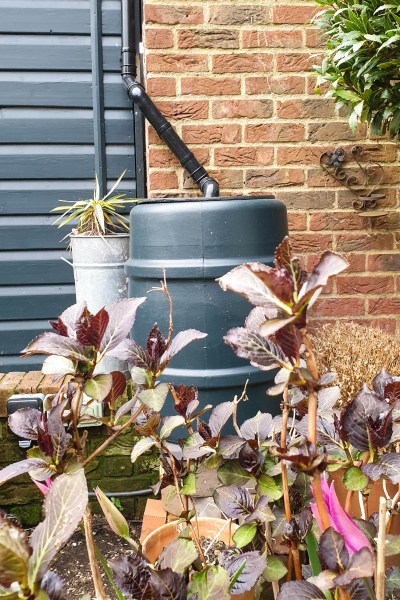
This 90 litre water butt doesn’t last long if you live in a dry area, but if you live in a rainy area, it would be more use.
If, however, we’d lived in a rainy part of the country, it would have re-filled over and over again. And when it is full, it’s really useful to have a water source in that part of the garden.
So I’m not saying anything against water butts. Just that you need them to be as large as possible.
I have two much larger water butts (total around 600 litres), connected to each other, taking the rainwater off two other sheds. These last for about two weeks when watering all the veg beds and pots. However, they are a very useful supply of water in a part of the garden that doesn’t have a tap.
You could get lots of water from your roof’s guttering. Many water butts today are sold with ‘diverter kits’ so you can divert your guttering rainwater into them. The Harcostar 350 litre Magnum Water butt with diverter is the one I’d choose if I was doing this.
But do make sure you’ve sorted out where water will go if the butt is full.
How much money does a water butt save you?
This made me realise how much water a garden uses.
If you’re metered, then water butts will save you some money, especially if you live in a rainy area. (That’s because they re-fill regularly.)
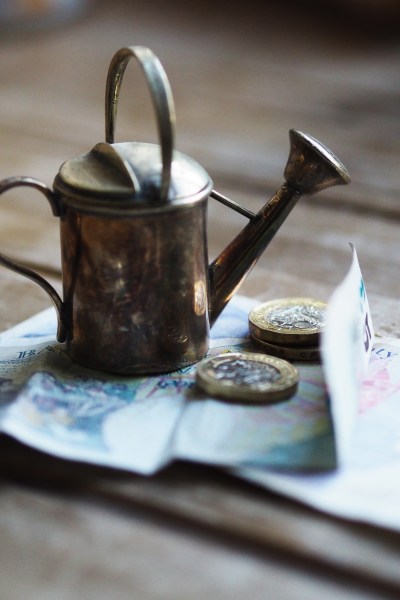
How much money does a water butt save you?
Thames Water says that a litre of tap water costs 0.097p. So my 90 litre water butt saves me about nine pence. The 600L water butts save me 60-70 pence between them.
At that rate, it would take you years to repay the cost of buying the water butt in the first place. However, they do last forever. And if you have a pond, it should be re-filled with rainwater, so a butt is the best way of getting that.
Plus there’s the bigger picture. If one gardener like me saves 600 litres of water in a fortnight, then one thousand gardeners could save 600,000 litres of water by using butts. That adds up to nearly two million litres of water saved in an average summer, even if the butts aren’t always refilled by rain. There are an estimated 27 million people who garden in the UK, so you can multiply that up again.
And we once had a bad household leak. It was the equivalent of a tap running day and night for three weeks. We got a water bill for £8,000. As it was a leak, we didn’t have to pay it, but it made me aware of how much water adds up to.
Re-using household water in the garden
Reusing household water for the garden is another commonly advised tip. It’s called ‘grey water’. My sister in law, for example, pours water from the condenser drier into a watering can to feed plants instead of throwing it down sink.
Although water down the sink is recycled by town sewage system, it has to be treated. So you’re adding to the volume of water that has to be treated. And, once again, you’re paying for the water that washes your clothes. You might as well get the most possible use out of it.
Other grey water options include washing up in a bowl and throwing the water out on the garden, but water containing strong detergents isn’t advised, so unless you use eco detergents that may not be the best thing to do. You can do something to your plumbing so that you can reuse shower and basin water for the garden. But in my view, this doesn’t come under ‘easy.’
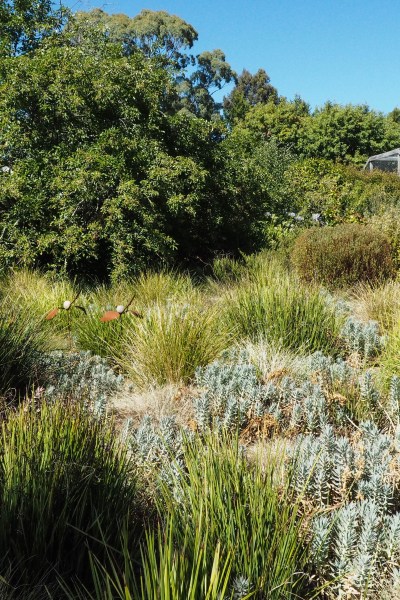
This part of Robin and Margaret Marks’ garden is irrigated and fed by pipes leading from the household grey water and treated sewage system.
Two of the gardens I visited near Melbourne had sewage and grey water systems set up to seep out through the garden soil. The sewage is treated, so it doesn’t smell. It fertilises the garden as well as keeping it watered. But this requires some serious plumbing changes – it’s probably only viable if you are doing some fairly major renovations.
Australian garden broadcaster Stephen Ryan runs the water from the roof of his house down into large tanks. Any overflow tops up his garden ponds.
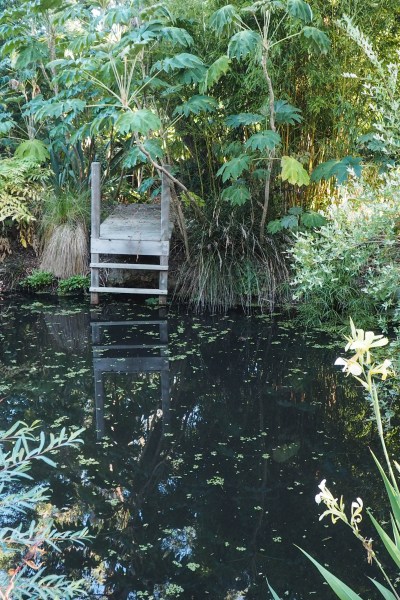
Rare plant expert and gardening broadcaster Stephen Ryan runs water from his guttering into tanks and has an overflow into his garden ponds.
Water saving garden hose
I find it useful to have a hose which switches off at the nozzle, because you don’t have to walk back to the tap between jobs. So you’re less likely to leave the hose on overnight. Leaving a hose to run can be very expensive if you’re metered.
We use a Flopro hose, which comes on a cart with an adjustable nozzle. I was sent it for review two years ago, and I’ve found it good. It doesn’t kink as much as our previous hose did, and the adjustable nozzle is very useful.
An adjustable nozzle also means you can leave a hose running very slowly around the base of a plant. The water will really sink into the soil.
Watering the lawn
We visited Melbourne this year at the end of an exceptionally dry summer. And nobody waters their lawns. Lawns go brown in hot, dry weather. They bounce back when the rain comes.
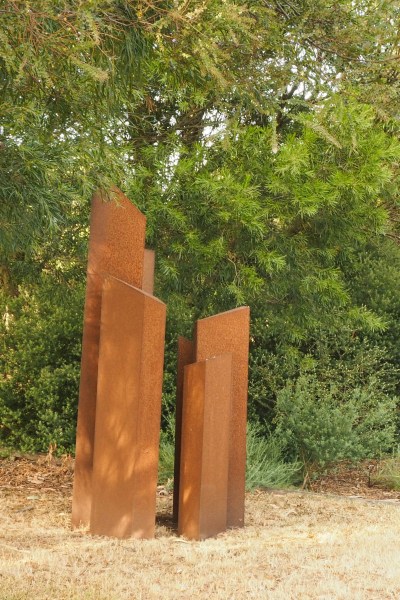
This sculpture is on a lawn, but Melbourne has had a very dry summer….the lawn will bounce back.
The only time you need to water a lawn is in its first summer. I remember top garden designer Charlotte Rowe looking at my newly laid lawn and telling me ‘Alexandra, you have to water that every day, even if it rains.’ And I did. But never since. One hour of a sprinkler on the lawn can use as much water as a family of four do in a day.
Watering other plants
Shrubs and perennials should survive, too, unless they’ve been recently planted. They definitely need watering in their first year. After that, you may decide to take a brisk attitude to plants that need cosseting. Once again, no sprinklers. Direct the water to the roots of the plant, leaving the rest of the soil dry.
Annual summer bedding, vegetables and pots will need regular watering.
Water first thing in the morning or in the evening. Some people say that evening watering in damp climates can lead to fungal diseases. But if you have a ‘damp climate’, you may not need to water.
Various tests have been run on whether watering in sunlight ‘scorches’ plants. The evidence is that it doesn’t – or you’d see far more wild plants looking ‘scorched.’ But the sun does evaporate the water, so it’s not ideal to water in the hot sun.
Water saving garden tips for pots
Plants in pots dry out more quickly than plants in the ground, so they need more watering.
The smaller the pot, the quicker it will dry out, although water retaining gels help. I was sent some Westland Water Retaining Gel to review. I found it effective in the slightly larger pots, but the smallest pots will always dry out quickly. You really do have to water them every day in the summer.
Grouping lots of small pots together helps stop some of the evaporation. And it makes it easier to water.
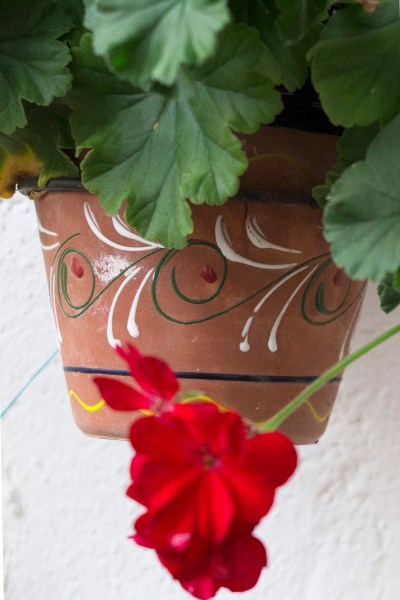
If you like small individual pots, then I’ve found that drought-resistant plants such as pelargoniums generally do best.
If you like having small pots around, then I’ve found that drought resistant plants, such as pelargoniums or succulents, are best.
Mulch, mulch, mulch
Almost everything in the garden seems to come back to mulching. Add a layer of compost, bark chips, wood chips or even lawn clippings to your borders to help stop water evaporating. Don’t dig it in. You’ll suppress annual weed seeds plus the mulch will eventually decompose and feed the plants.
Last year I started protecting a couple of new plants – a rose and a silver birch – with a cardboard mulch. I laid cardboard flat on the earth around the plant, covering the approximate root area. Then I added compost on top to disguise the cardboard. I did a post about this as a way of weeding without chemicals, but it also helped the plants survive the drought.
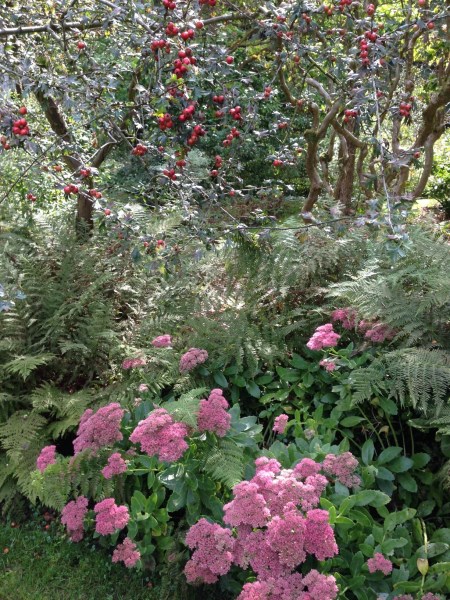
Plants that survive drought well include sedum and I’ve found that Rosa glauca is resilient to most weather conditions.
If you’re buying compost, the RHS says that we should not be using peat-based composts. (And isn’t it a bit contradictory to save water while not saving peat?).
I’ve been sent some Westland New Horizon Peat-free compost to try. So far, I’ve found it excellent for sowing seeds. I also use my homemade compost for mulching, too.
And if you’re having work done…
If you’re doing any major work in the garden, you can build water-saving in. I would love to have an irrigation system but only if it had a programming mechanism. And I don’t want it fed directly from the garden tap.
We tried out an irrigation system a few years ago which was connected to our garden tap. But it meant we had to turn the tap on and off to get the irrigation working. It was also a nuisance to have to take it off the tap when we wanted to use the hose or watering cans.
And because you can’t see the water flowing with an irrigation system, I thought it might be too easy to leave it on. As we’re metered, that could be very expensive.
I have since been recommended this garden tap lever fitting that has two tap outlets. It means you could run the irrigation system and still use the second tap outlet for a hose or watering can. However, I haven’t tried it personally.
See here for more money saving gardening tips. And here is a post on how to save money on garden design.
Pin for reference
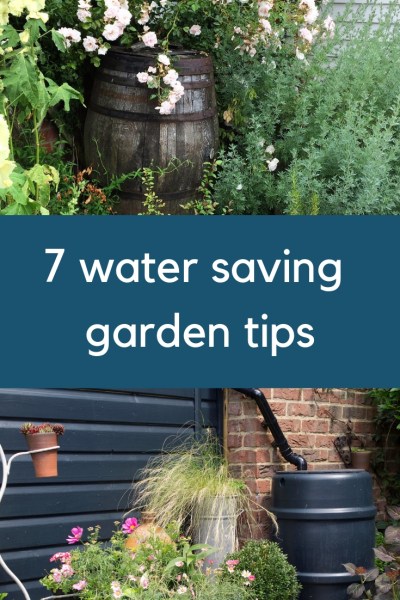
























Nice read. Collecting rain water for the garden is the best method for protecting the planet and not wasting minerals
I agree, although I was surprised to get a comment from North America on my YouTube video saying that in some areas there, there are restrictions on how much rainwater you’re allowed to collect. It’s something to do with ancient rights.
Great Share
This is wonderful article enjoyed reading the article above , really explains everything in detail,the article is very interesting and effective.Thank you and good luck for the upcoming articles.
I really appreciate it.
Thank you.
A good article.
One thing to be careful of – if you have fish in your ponds it is not a good idea to use rainwater from a butt. A pond filled from a tap will be quite alkaline, whilst our rain water tends to be slightly acidic and changing the pH of the water by adding rain water can cause the fish to go into shock.
If you are topping up a natural pond that has been rain-filled this won’t be such a problem, but ponds to change their alkalinity over time so it’s safer to use the rainwater on plants.
Thank you, that’s interesting.